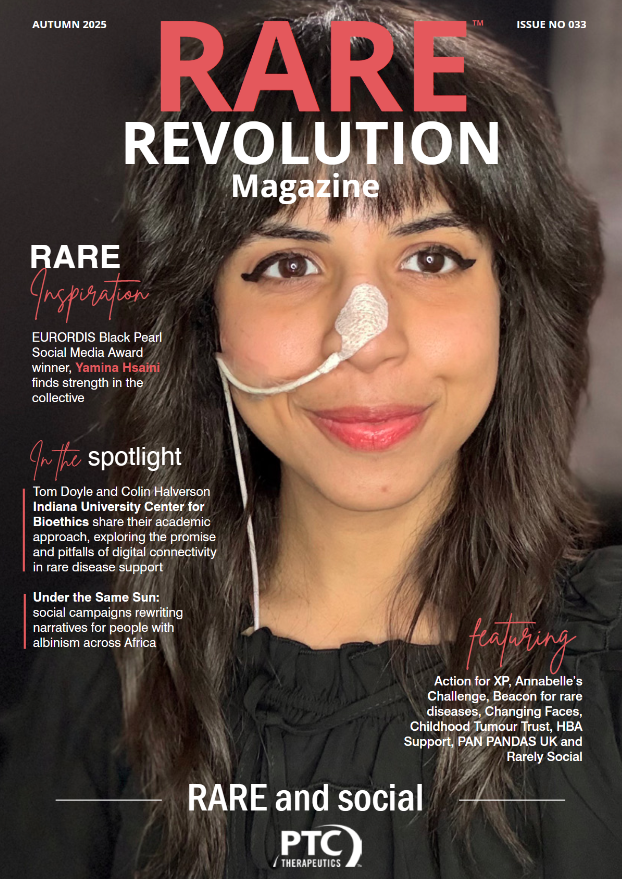Navigating rare waters, Laura’s journey with a rare liver condition: PFIC3

Laura Søe Jakobsen was diagnosed with a rare condition that affects the liver called progressive familial intrahepatic cholestasis (PFIC) type 3 (PFIC3). People with PFIC3 generally develop signs and symptoms during late infancy or early childhood. In Laura’s case, she was not diagnosed until she was 14.
Written by Geoff Case, RARE Revolution Magazine

Life with PFIC has certainly been “bumpy”, says Laura Søe Jakobsen, a 23-year-old woman from Denmark. “The type of PFIC I have is PFIC3,” she says. “There are several different types, but I have number three, and one of the symptoms is not gaining weight—I was always a tiny kid.”
Laura was frequently ill through her school years, but in seventh grade, when she was 14, she had a stomach-ache that just wouldn’t go away. When her mom took her hospital, they found her gall bladder was “full of stones” and needed to be removed at once.
The doctors could see from blood tests that she had a serious issue with her liver but they couldn’t find a cause. “The numbers that indicate the health of your liver were just skyrocketing, and they couldn’t bring them down,” she says.
For the next two years, Laura spent most of her time in hospital. “I wasn’t able to go to school. I was too weak, too exhausted. I ate like normal, but my body just couldn’t process the foods.” Eventually, a specialist at a university hospital in Denmark arranged genetic testing, enabling a diagnosis of PFIC3.
After that long wait, Laura was finally able to receive appropriate care and, thankfully, her health quickly improved. “I was a lucky case. I started gaining weight—I was really skinny—and I started eating better, and I started feeling a lot better. When you have liver issues, your skin turns yellow but that went away, and I stabilised for a while.”


Laura’s next stop in her PFIC journey was a children’s hospital in the United States, where she was cared for by a leading PFIC specialist. “This did more for me and my health that I could’ve ever imagined,” she explains gratefully.
After three years in US, Laura is now back in Denmark on a pathway that is appropriate to her and “living an almost normal life”, but PFIC had an enormous impact on her health and education during her teenage years.
As she explains, the teenage years are a time “when you don’t want to be different, you want to be like everybody else. You just want to be a teenager”. But having such pressing health challenges inevitably made her feel different.
“I was not like everyone else, and I knew that,” she says. “It was a difficult feeling because I stuck out and didn’t live a normal teenage life… I lived in a hospital.”
Her poor health placed a great burden on her family. Her mom had stopped working and could take Laura to hospital, staying with her so she wasn’t alone. And when her mom wasn’t at the hospital, she spent her time finding out as much as she could about PFIC3. It was hard for her father too because he became the sole earner in the household. That pressure on her parents, in turn, put pressure on Laura to be as independent as possible, to lessen the burden on them.
The middle of three children, Laura recognised even back then how her younger brother and older sister tended to be overlooked because of her condition. Unwillingly, she became the centre of attention. She remembers how “family members would call and always ask, ‘How’s Laura doing? And how about the other two?’”
Since then, Laura has talked a lot with her siblings about this tough time and found out more about the burden they carried. Her little brother, who’s two years younger, has always tried his best to be supportive, though he might have felt overlooked, and her elder sister, who’s seven years older, “felt bad” that she “couldn’t take the disease away”.
However, Laura looks back with fondness at how, overall, this turmoil united her family. “It was really beautiful to watch us come together as a family,” she says. “It was difficult when it was really hard, but we were definitely there for each other.”


When Laura was first diagnosed, she says she felt “like an alien” when she found out how rare PFIC is—and people’s reluctance to talk about her health didn’t help. “I think that’s quite a normal reaction, though. I think they might have been scared that I would get sad or angry… and it was hard to explain it every time, too.”
When Laura attended the first PFIC Network conference, in Cincinnati, Ohio, in 2019, she met with people living with PFIC from around the world, parents of children with PFIC, and doctors who specialise in these conditions. She has never felt “more seen and heard and validated” than she did there, she says, and it made her feel “secure” to be able to talk with “the doctors who had written the books that other doctors had read on PFIC”.
Remembering how her family were so worried about what PFIC meant for her, Laura believes that conferences and online support groups have enormous value in bringing families answers. At the conference, she was saddened to hear that in some countries “no one knew about the disease—the knowledge just hadn’t gotten there”.
One of the conference attendees was a young woman of Laura’s age. She had been diagnosed when she was just six months old and had a liver transplant before she was one. Meeting her was a wonderful experience, she says:
“It was very liberating to meet somebody my age who understands what it’s like to be so different… somebody who really understands, somebody I could share these experiences with.”
– Laura

Looking back, Laura feels the experience of being “different” and “sticking out” gave her a solid foundation to rethink her image of herself. PFIC forced a difference upon her that felt “very scary and very uncomfortable” but she has since found peace in being different. The strength this has given her has helped to make her the self-assured and positive woman she is today. “I think that 15-year-old Laura would be proud of 23-year-old Laura today,” she says with a smile.
With her knowledge of PFIC having increased so much since her diagnosis seven years ago, Laura has grown much more confident in talking to people about it. Talking about illness, rather than treating it as “the elephant” in the room is validating for her and, she believes, for many people living with chronic conditions and disability. Each discussion she has about PFIC also creates an opportunity for her to raise awareness of these rare conditions, which few people, including doctors, know about.
Looking to the future, Laura hopes to see ever-growing awareness of PFIC, so that affected families can find the education and support they need. Above all, she wants families to know that PFIC need not define their child’s future.
For herself, after her long PFIC journey she hopes that her health will remain stable, allowing her to continue her clerical work at a Danish harbour. Above all, she hopes that science and medicine will progress further to help her and others affected by PFIC.
“I have a really great social life, and I just hope that I can keep working the way I do, going out with my friends like any 23-year-old girl.”
– Laura
Any medical information included in this article is not intended to form medical advice. It must not be used as a tool to help understand or assess potential options around diagnosis and treatment. Patients must consult a doctor to receive medical advice, diagnosis and treatment that is appropriate to their specific and unique circumstances.
***
Ipsen has provided sponsorship to support the production and distribution of this article. Ipsen had no influence over the choice of speaker and had no editorial input into the content of the article, other than a review for medical accuracy. All opinions are those of the contributors and there was no transfer of value for participation. RARE Revolution Magazine and IPSEN are not responsible for the content of any external sites linked to or referred to within this article. RARE Revolution Magazine retains all copyright.
Date of preparation: August 2024 – BYL-PFIC-ALL-000063






